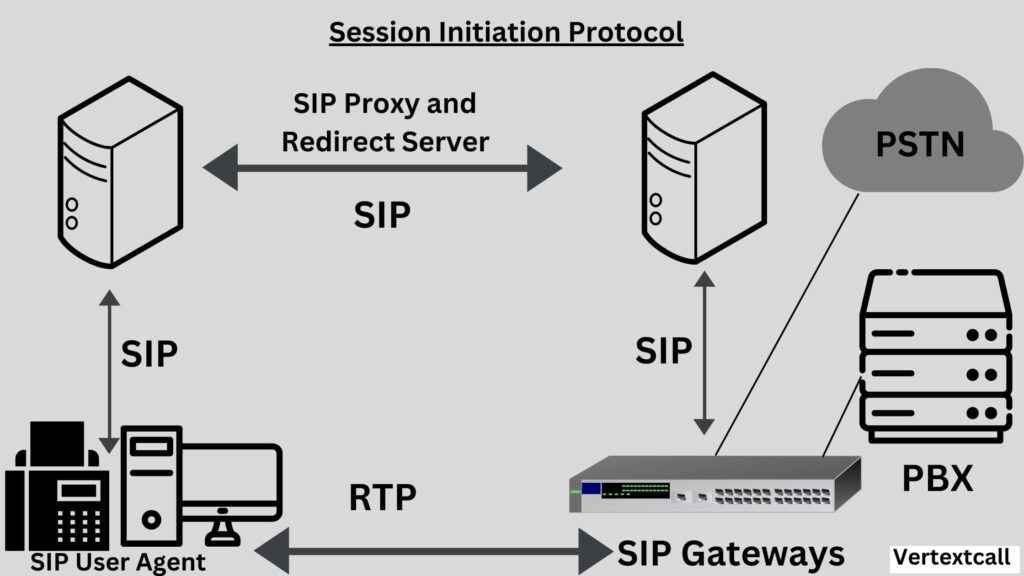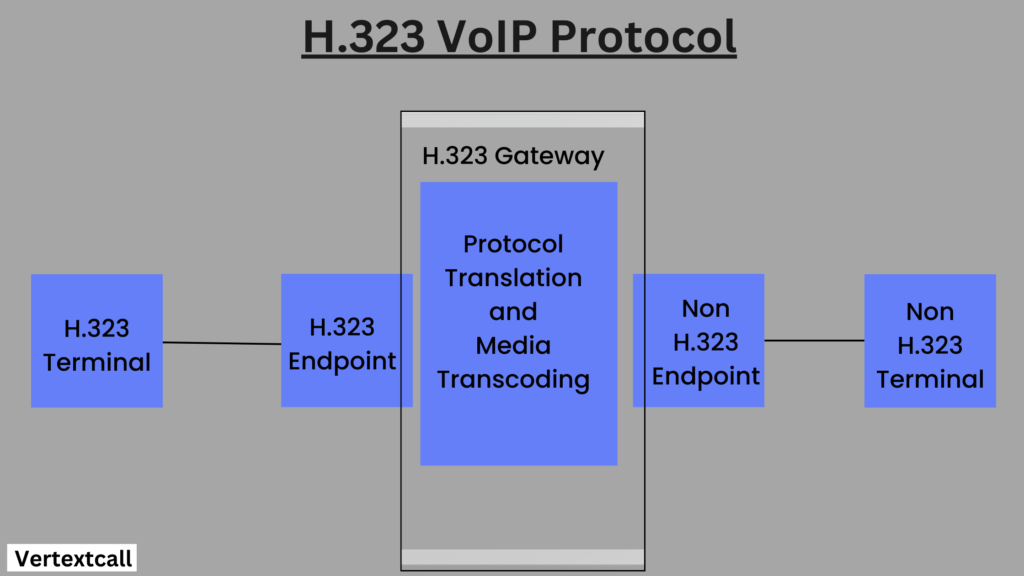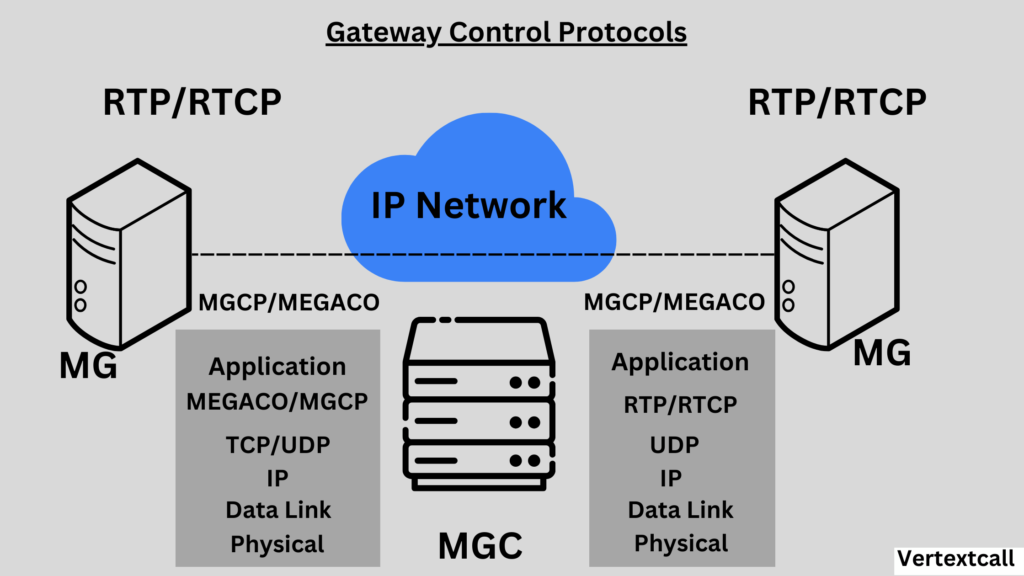The demand for efficient and affordable communication solutions is higher than ever. This is where VoIP plays a crucial role by offering a digital framework for transmitting audio and video data over the internet. A key element for VoIP success is the protocol enabling communication. This thorough guide explores various VoIP protocols and their roles in enhancing your communication framework.
List of VoIP Protocols
- Session Initiation Protocol (SIP)
- H.323
- Media Gateway Control Protocol (MGCP)
- Real-time Transport Protocol (RTP)
- Real-time Transport Control Protocol (RTCP)
- Secure Real-time Transport Protocol (SRTP)
- Resource Reservation Protocol (RSVP)
- Inter-Asterisk eXchange Protocol (IAX)
- Session Description Protocol (SDP)
- Session Announcement Protocol (SAP)
- Extensible Messaging and Presence Protocol (XMPP)
- H.248 (Megaco)
- Skinny Client Control Protocol (SCCP)
What are VoIP Protocols?
VoIP protocols are sets of technical rules and procedures that govern the transmission of voice and multimedia communication over the Internet or other packet-switched networks. These protocols are designed to efficiently convert analog voice signals into digital data packets, allowing them to be sent over the Internet.
This conversion and transmission process enables you to make voice calls without the need for traditional telephone lines, utilizing the extensive infrastructure of the global internet to reduce costs and increase flexibility in communication methods.
What are the types of VoIP protocols?
There are several types of VoIP protocols, each serving different functions within the VoIP ecosystem. Here are some common types:
1/ SIP (Session Initiation Protocol):
Developed by the Internet Engineering Task Force (IETF), the Session Initiation Protocol (SIP) is one of the most commonly used protocols for handling interactive multimedia communication sessions.

SIP can create, modify, and terminate sessions involving one or more participants. In a VoIP context, SIP sets up and manages voice and video calls and instant messaging. This flexibility makes SIP critical in establishing a reliable and flexible VoIP communication system.
2/ H.323:
Originally developed for multimedia communications over packet-switched networks, H.323 is another pivotal VoIP protocol. Its primary focus is on providing standards for equipment, networks, and services for audio, video visual, and data exchanges within IP-based networks, such as the Internet.

Unlike SIP, which deals mainly with initiating and ending communication sessions, H.323 offers a broader range of protocols. These protocols include specifications for call signaling, multimedia transmission, and bandwidth control, addressing both individual and conference communications.
Moreover, H.323 defines elements like gateways and gatekeepers, providing ways to connect with traditional telephony systems and manage traffic and bandwidth effectively.
3/ MGCP (Media Gateway Control Protocol):
MGCP, known as the Media Gateway Control Protocol specifically focuses on managing media gateways through external call control elements. It simplifies the connection between the public switched telephone network and VoIP systems by assigning call control and management tasks to central controllers, called call agents.

MGCP efficiently handles the conversion of audio signals from traditional phone lines to data packets sent over the Internet or other IP networks. By separating call processing from gateway functions, MGCP allows for more scalable and easily manageable network structures, enabling easy voice, fax, and multimedia transmissions across various network setups.
4/ RTP (Real-time Transport Protocol):
The Real-time Transport Protocol (RTP) is a fundamental VoIP protocol designed to handle the delivery of real-time data, including audio and video, over network services. Unlike the control or signaling protocols such as SIP or MGCP, RTP focuses purely on the transport and packetization of multimedia content.
It operates in end-to-end communication sessions, ensuring that media streams are delivered on time and in the correct sequence, which is critical for maintaining the quality of voice and video calls over IP networks.
5/ RTCP (Real-time Transport Control Protocol)
The Real-time Transport Control Protocol (RTCP) works alongside the Real-time Transport Protocol (RTP) to uphold the quality standard crucial for multimedia communication across IP networks. While RTP carries the actual media stream—be it audio, video, or both—RTCP works in the background, providing the necessary oversight and feedback mechanisms.
It focuses on monitoring the delivery of data and collecting statistics on packet loss, delay, and jitter, which are crucial for evaluating the quality of service (QoS). This feedback is shared with participants in the communication process, allowing for dynamic adjustments to enhance the communication experience.
6/ Secure Real-time Transport Protocol (SRTP):
SRTP, the Secure Real-time Transport Protocol, extends the capabilities of Real-time Transport Protocol (RTP) that enhances security for media streams by providing encryption, message authentication, and integrity verification.
In VoIP and multimedia applications, SRTP is crucial for ensuring secure voice and video communications over IP networks. By employing powerful encryption mechanisms, SRTP protects critical data against interception and unauthorized access, thereby preserving the privacy of the interactions.
Additionally, its message authentication and authenticity features prevent tampering and replay attacks, securing the integrity of the transmitted data. Given the increasing concerns of cyber security and privacy in digital communications, SRTP serves as a vital tool for businesses and individuals aiming to secure their voice and video calls against external threats.
Through its enhancement of RTP with security features, SRTP enables the safe, reliable exchange of multimedia content, critical for maintaining trust and privacy in online communications.
7/ RSVP (Resource Reservation Protocol):
RSVP, or Resource Reservation Protocol, stands out as a key network protocol customized for reserving resources within an IP network. Its core purpose is to enable internet applications to efficiently request and secure resources through the network in a flexible and scalable manner.
This protocol facilitates the allocation of bandwidth required for each session’s needs, assisting in managing network traffic to fulfill Quality of Service (QoS) standards for multimedia transmissions, such as voice and video communications.
Unlike conventional IP routing which treats all packets uniformly, RSVP allows for traffic differentiation by prioritizing specific streams based on preset rules. This feature is vital to ensuring that VoIP and other real-time communication apps deliver top performance, even during network overload.
8/ IAX (Inter-Asterisk eXchange Protocol):
The Inter-Asterisk eXchange Protocol, known as IAX, is a specialized VoIP protocol mainly used in the Asterisk private branch exchange (PBX) system. Unlike other VoIP protocols, IAX is adapted to meet the unique needs of the Asterisk PBX, enabling efficient communication between servers and clients in a VoIP network.
One of IAX’s key advantages is its ability to navigate firewalls and network address translators (NATs) easily by using a single UDP port for both signaling and data. This simplifies network setup while enhancing security by reducing open ports on the firewall.
Furthermore, IAX enables multiplexing of multiple voice calls over a single connection, reducing overhead and bandwidth usage. With its reliable capabilities designed for Asterisk-based systems, IAX plays a crucial role in enabling efficient, secure, and high-quality VoIP communication within and across networks.
Related Stats: The results of experiments indicate that the Asterisk PBX can efficiently manage over 160 simultaneous voice calls with a blocking probability below 5%.
9/ Session Description Protocol (SDP):
The Session Description Protocol (SDP) serves a foundational role in the initiation and management of multimedia sessions in VoIP and other streaming media applications. SDP is employed for describing multimedia sessions to ensure successful communication between endpoints.
It conveys critical information such as the type of media (audio, video, etc.), the codec used, and connection details including IP address and port number, enabling the setup of calls and conferences.
10/ Session Announcement Protocol (SAP):
The Session Announcement Protocol (SAP) is crucial for efficiently spreading multimedia session information across networks. Unlike SDP, which details multimedia sessions, SAP focuses on announcing and displaying these sessions to potential participants. It works by broadcasting session announcement packets with SDP descriptions over a network. This method lets SAP inform participants about upcoming multimedia sessions like webcasts or large-scale video conferences, including their timing and technical specs.
11/ XMPP (Extensible Messaging and Presence Protocol):
The Extensible Messaging and Presence Protocol (XMPP) is a communications protocol that prioritizes the open standard for online message and presence exchange. Using Jabber technology, XMPP provides a framework for instant messaging (IM), presence details, and contact list management.
Its extensible nature allows it not only to facilitate near real-time text-based communication but also to support a diverse range of messaging features such as group chat, voice and video calls, file transfer, and more.
12/ H.248 (Megaco):
The H.248 protocol, also known as Megaco, is a pivotal standard in the telecommunications domain, particularly for managing gateways that interface between public switched telephone networks (PSTNs) and voice over Internet Protocol (VoIP) networks.
Its primary function is to control the signaling and media gateways at the boundary of IP networks, enabling uninterrupted voice, fax, and multimedia sessions over IP networks.
One of the distinctive features of H.248 is its ability to break down complex multimedia gateways into simpler elements, making it easier to manage various media streams. This breakdown supports a variety of services by allowing independent control of each element, enhancing the flexibility and scalability of network architectures.
By offering a solid framework for gateway management, H.248 ensures high-quality, secure, and reliable voice and multimedia communication across different network setups.
13/ Skinny Client Control Protocol (SCCP):
The Skinny Client Control Protocol (SCCP) is a proprietary network protocol created by Cisco Systems, serving a crucial role in Voice over Internet Protocol (VoIP) communications, especially within the Cisco Unified Communications Manager ecosystem. SCCP is designed for efficient communication between VoIP devices like IP phones and a central server, enabling features such as call control, signaling, and session management with minimal bandwidth usage.
What is the difference between VoIP and SIP protocols?
VoIP (Voice over Internet Protocol) and SIP (Session Initiation Protocol) both serve distinct functions and operate at different layers of the communication process. Here are the key differences between the two:
1/ Protocol Layer: SIP is an application layer protocol that can set up real-time multimedia sessions between participants. VoIP is not a protocol but a set of technologies that utilize various protocols, including SIP, for voice communication over IP networks.
2/ Scope of Application: VoIP covers all Internet-based communication that was traditionally managed through the public switched telephone network (PSTN), including voice, fax, and SMS. On the other hand, SIP functions as a signaling protocol for overseeing real-time sessions that include video, voice, messaging, and a range of communication applications and services.
3/ Functionality: VoIP focuses on the transmission of voice data over internet connections. Conversely, SIP is capable of handling various types of multimedia communication, not limited to voice, including video calls and conferencing sessions.
4/ Interoperability and Integration: SIP, by its very nature, supports a higher degree of interoperability among different devices and networks, facilitating complex multimedia communications. VoIP, as a broader category, may utilize different protocols that do not guarantee this level of interoperability.
5/ Examples: Examples of VoIP systems include Skype, WhatsApp Calls, and enterprise VoIP solutions. In comparison, examples of SIP implementations include SIP-based softphones, IP phones, and SIP servers such as Asterisk.
Related Reading: SIP Versus VoIP
Comparison of VoIP Protocols
Protocols | Primary Function | Use Case | Strengths | Limitations |
SIP (Session Initiation Protocol) | Initiates, maintains, and terminates real-time sessions | Wide-ranging, from voice and video calls to instant messaging | Highly flexible and compatible; Internet-centric design | Complexity in configuration and management |
H.323 | Multimedia communication over networks without guaranteed QoS | Traditional videoconferencing and VoIP systems in enterprises | Comprehensive framework; resilient in enterprise environments | Less flexible; seen as outdated compared to newer protocols |
MGCP (Media Gateway Control Protocol) | Control of media gateways by external call control elements | Used in centralized architecture systems to manage voice, fax, and telephony services | Simplifies gateway administration; allows centralized control | Less scalable and adaptable compared to distributed protocol architectures |
RTP (Real-time Transport Protocol) | End-to-end network transport functions for applications requiring real-time transmission | Streaming audio, video, telephony applications | Supports multimedia streaming; provides payload type identification and sequence numbering | Does not provide guaranteed delivery or quality of service |
RTCP (Real-time Transport Control Protocol) | Provides out-of-band statistics and control information for an RTP flow | Works alongside with RTP to provide feedback on the quality of service | Facilitates monitoring and management of QoS; supports synchronization | Bandwidth overhead; does not itself transport application data |
RSVP (Resource Reservation Protocol) | Resource reservation for streaming media | Setting up Internet multimedia sessions and reserving resources across a network | Enables reservation of bandwidth for critical applications | Complex to implement; scalability issues in large networks |
IAX (Inter-Asterisk eXchange Protocol) | Facilitates VoIP connections between Asterisk servers | Used primarily within Asterisk PBX systems for handling VoIP calls | Minimal bandwidth usage; NAT traversal; supports trunking | Limited use outside of Asterisk systems |
SRTP (Secure Real-time Transport Protocol) | Provides encryption, message authentication and integrity for RTP | Secure transmission of multimedia across untrusted networks | Enhances RTP by adding security features | Additional processing overhead; requires mechanisms for key management |
SDP (Session Description Protocol) | Describes multimedia sessions for the purposes of session announcement and invitation | Used with SIP and other signaling protocols for initiating multimedia sessions | Simplifies session setup by describing the media format and destination | Does not offer session management; purely descriptive |
SAP (Session Announcement Protocol) | Advertising multimedia sessions | Announcing multicast sessions to prospective participants | Facilitates session discovery and advertisement | Relatively simple; relies on multicast which is not universally supported |
XMPP (Extensible Messaging and Presence Protocol) | Handles instant messaging, presence information, and contact list maintenance | Messaging, collaborative environments, real-time communication applications | Extensible and open standard; rich in features | More focused on messaging than VoIP |
H.248/Megaco | Protocol for controlling media gateways in a multimedia session | Large scale VoIP and multimedia services; gateway control | Offers detailed control of media gateways; scalable | Complexity due to detailed control capabilities |
SCCP (Skinny Client Control Protocol) | Proprietary protocol for terminal control (Cisco Systems) | Cisco VoIP systems | Optimized for Cisco hardware; supports a rich feature set | Limited to Cisco environments; lack of openness compared to SIP |
Frequently Asked Questions
Q1) What are the three types of VoIP services?
Ans: The three types of VoIP services include Hosted VoIP systems, In-house VoIP Systems, and Hybrid VoIP Services. Hosted VoIP systems are managed remotely by a service provider, providing businesses with advanced telephony features without the need to handle the infrastructure. In-house VoIP Systems offer businesses complete control over the VoIP infrastructure but require internal technical expertise for maintenance. Hybrid VoIP Services combine traditional telephony systems with VoIP technology, allowing a steady transition to VoIP while still using existing telephone lines.
Q2) What are the most used VoIP protocols?
Ans: The most used VoIP protocols are SIP (Session Initiation Protocol), the basis for real-time communication sessions covering voice, video, and messaging; H.323, used in professional settings for video conferences and voice calls via IP networks and RTP (Real-Time Protocol), handling audio and video transmission for quality communication.
Q3) What protocols are needed for VoIP?
Ans: The essential protocols needed for VoIP include SIP (Session Initiation Protocol), H.323, RTP (Real-Time Protocol), and IAX (Inter-Asterisk eXchange). Together, these protocols form the basis of VoIP services, ensuring reliable internet-based telephony for continuous communication experiences.
Q4) What are the two major protocols for VoIP signaling?
Ans: The two primary protocols for VoIP signaling are SIP (Session Initiation Protocol) and H.323. SIP stands out for its adaptability and wide compatibility with various devices and networks, making it a go-to option for many businesses. On the other hand, H.323, while less common than SIP, is valued for its reliability in specialized settings like video communication via satellite connections. These protocols form the core of VoIP communications, ensuring efficient transmission of voice data across IP networks.
Q5) Is VoIP a TCP or UDP?
Ans: VoIP utilizes both TCP (Transmission Control Protocol) and UDP (User Datagram Protocol), depending on the specific requirements of the communication session. While TCP offers error correction and ensures the delivery of data packets in the correct order, which is beneficial for file transfers or secure communications, UDP is preferred for VoIP due to its lower latency. UDP allows for quicker transmission of voice packets, which is essential for maintaining call quality and reducing delays.
Q6) Is VoIP an RTP or UDP?
Ans: VoIP employs both RTP (Real-Time Protocol) and UDP (User Datagram Protocol) in its operation. RTP is built on top of UDP and is used for the transport of real-time data, such as audio and video. This protocol provides mechanisms for time marking and order, crucial for assembling the media stream at the receiving end. UDP, by its nature, allows for the faster transmission of data packets, which is essential for real-time communication services like VoIP, where latency can greatly affect the quality of the conversation.
Q7) Does VoIP use TCP protocol?
Ans: Yes, VoIP can use the TCP (Transmission Control Protocol) along with UDP (User Datagram Protocol) for the transportation of voice data over Internet Protocol networks. TCP ensures the reliable delivery of data packets and is used in scenarios where packet order and integrity are critical, such as file transfers or loading web pages.

